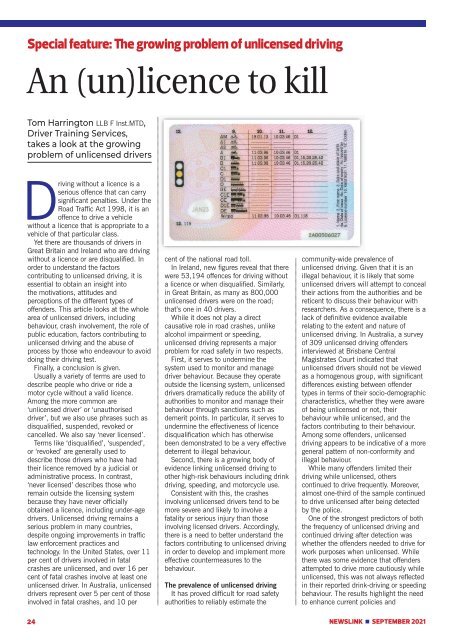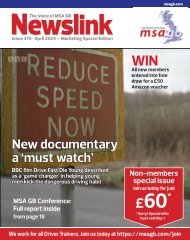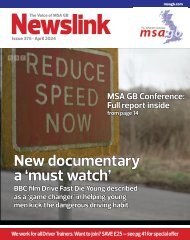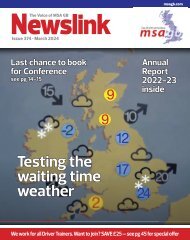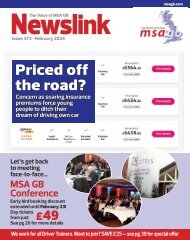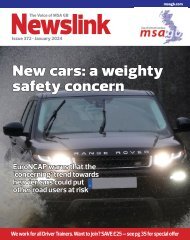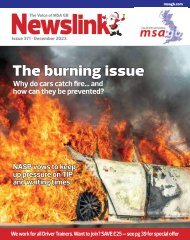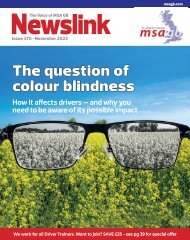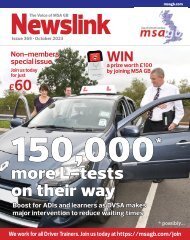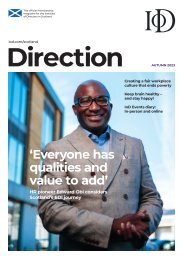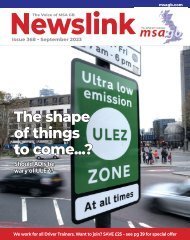Newslink September 2021
Motor Schools Association of Great Britain membership magazine; driving instructors, road safety, motoring news
Motor Schools Association of Great Britain membership magazine; driving instructors, road safety, motoring news
- No tags were found...
You also want an ePaper? Increase the reach of your titles
YUMPU automatically turns print PDFs into web optimized ePapers that Google loves.
Special feature: The growing problem of unlicensed driving<br />
An (un)licence to kill<br />
Tom Harrington LLB F Inst.MTD,<br />
Driver Training Services,<br />
takes a look at the growing<br />
problem of unlicensed drivers<br />
Driving without a licence is a<br />
serious offence that can carry<br />
significant penalties. Under the<br />
Road Traffic Act 1998, it is an<br />
offence to drive a vehicle<br />
without a licence that is appropriate to a<br />
vehicle of that particular class.<br />
Yet there are thousands of drivers in<br />
Great Britain and Ireland who are driving<br />
without a licence or are disqualified. In<br />
order to understand the factors<br />
contributing to unlicensed driving, it is<br />
essential to obtain an insight into<br />
the motivations, attitudes and<br />
perceptions of the different types of<br />
offenders. This article looks at the whole<br />
area of unlicensed drivers, including<br />
behaviour, crash involvement, the role of<br />
public education, factors contributing to<br />
unlicensed driving and the abuse of<br />
process by those who endeavour to avoid<br />
doing their driving test.<br />
Finally, a conclusion is given.<br />
Usually a variety of terms are used to<br />
describe people who drive or ride a<br />
motor cycle without a valid licence.<br />
Among the more common are<br />
‘unlicensed driver’ or ‘unauthorised<br />
driver’, but we also use phrases such as<br />
disqualified, suspended, revoked or<br />
cancelled. We also say ‘never licensed’.<br />
Terms like ‘disqualified’, ‘suspended’,<br />
or ‘revoked’ are generally used to<br />
describe those drivers who have had<br />
their licence removed by a judicial or<br />
administrative process. In contrast,<br />
‘never licensed’ describes those who<br />
remain outside the licensing system<br />
because they have never officially<br />
obtained a licence, including under-age<br />
drivers. Unlicensed driving remains a<br />
serious problem in many countries,<br />
despite ongoing improvements in traffic<br />
law enforcement practices and<br />
technology. In the United States, over 11<br />
per cent of drivers involved in fatal<br />
crashes are unlicensed, and over 16 per<br />
cent of fatal crashes involve at least one<br />
unlicensed driver. In Australia, unlicensed<br />
drivers represent over 5 per cent of those<br />
involved in fatal crashes, and 10 per<br />
cent of the national road toll.<br />
In Ireland, new figures reveal that there<br />
were 53,194 offences for driving without<br />
a licence or when disqualified. Similarly,<br />
in Great Britain, as many as 800,000<br />
unlicensed drivers were on the road;<br />
that’s one in 40 drivers.<br />
While it does not play a direct<br />
causative role in road crashes, unlike<br />
alcohol impairment or speeding,<br />
unlicensed driving represents a major<br />
problem for road safety in two respects.<br />
First, it serves to undermine the<br />
system used to monitor and manage<br />
driver behaviour. Because they operate<br />
outside the licensing system, unlicensed<br />
drivers dramatically reduce the ability of<br />
authorities to monitor and manage their<br />
behaviour through sanctions such as<br />
demerit points. In particular, it serves to<br />
undermine the effectiveness of licence<br />
disqualification which has otherwise<br />
been demonstrated to be a very effective<br />
deterrent to illegal behaviour.<br />
Second, there is a growing body of<br />
evidence linking unlicensed driving to<br />
other high-risk behaviours including drink<br />
driving, speeding, and motorcycle use.<br />
Consistent with this, the crashes<br />
involving unlicensed drivers tend to be<br />
more severe and likely to involve a<br />
fatality or serious injury than those<br />
involving licensed drivers. Accordingly,<br />
there is a need to better understand the<br />
factors contributing to unlicensed driving<br />
in order to develop and implement more<br />
effective countermeasures to the<br />
behaviour.<br />
The prevalence of unlicensed driving<br />
It has proved difficult for road safety<br />
authorities to reliably estimate the<br />
community-wide prevalence of<br />
unlicensed driving. Given that it is an<br />
illegal behaviour, it is likely that some<br />
unlicensed drivers will attempt to conceal<br />
their actions from the authorities and be<br />
reticent to discuss their behaviour with<br />
researchers. As a consequence, there is a<br />
lack of definitive evidence available<br />
relating to the extent and nature of<br />
unlicensed driving. In Australia, a survey<br />
of 309 unlicensed driving offenders<br />
interviewed at Brisbane Central<br />
Magistrates Court indicated that<br />
unlicensed drivers should not be viewed<br />
as a homogenous group, with significant<br />
differences existing between offender<br />
types in terms of their socio-demographic<br />
characteristics, whether they were aware<br />
of being unlicensed or not, their<br />
behaviour while unlicensed, and the<br />
factors contributing to their behaviour.<br />
Among some offenders, unlicensed<br />
driving appears to be indicative of a more<br />
general pattern of non-conformity and<br />
illegal behaviour.<br />
While many offenders limited their<br />
driving while unlicensed, others<br />
continued to drive frequently. Moreover,<br />
almost one-third of the sample continued<br />
to drive unlicensed after being detected<br />
by the police.<br />
One of the strongest predictors of both<br />
the frequency of unlicensed driving and<br />
continued driving after detection was<br />
whether the offenders needed to drive for<br />
work purposes when unlicensed. While<br />
there was some evidence that offenders<br />
attempted to drive more cautiously while<br />
unlicensed, this was not always reflected<br />
in their reported drink-driving or speeding<br />
behaviour. The results highlight the need<br />
to enhance current policies and<br />
24<br />
NEWSLINK n SEPTEMBER <strong>2021</strong>


